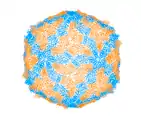Phytoreovirus
Phytoreovirus is a genus of viruses, in the family Reoviridae, in the subfamily Sedoreovirinae. They are non-turreted reoviruses that are major agricultural pathogens, particularly in Asia.[1] Oryza sativa for RDV and RGDV, dicotyledonous for WTV, and leafhoppers serve as natural hosts. There are currently three species in this genus including the type species Wound tumor virus. Diseases associated with this genus include: WTV: galls (tumor). RDV: dwarf (or stunt) disease of rice. RGDV: dwarfing, stunting, and galls.[2][3]
| Phytoreovirus | |
|---|---|
 | |
| Cryo-EM of protein capsid structure of rice dwarf virus (RDV) | |
| Virus classification | |
| (unranked): | Virus |
| Realm: | Riboviria |
| Kingdom: | Orthornavirae |
| Phylum: | Duplornaviricota |
| Class: | Resentoviricetes |
| Order: | Reovirales |
| Family: | Reoviridae |
| Subfamily: | Sedoreovirinae |
| Genus: | Phytoreovirus |
| Type species | |
| Wound tumor virus | |
Classification
One member of this family, Rice Dwarf Virus (RDV), has been extensively studied by electron cryomicroscopy and x-ray crystallography. From these analyses, atomic models of the capsid proteins and a plausible model for capsid assembly have been derived. While the structural proteins of RDV share no sequence similarity to other proteins, their folds and the overall capsid structure are similar to those of other Reoviridae.[1]
Phytoreoviruses are unique among Reoviridae in that there are 12 dsRNA segments in each virus. Like all other Reoviridae, they contain their own RNA-dependent RNA polymerase, allowing for endogenous synthesis of viral mRNA within the virus. Although less well studied than orthoreovirus and orbivirus, considerable structural and biochemical studies have been undertaken to characterize phytoreoviruses, which in general infect plants. There are three recognized phytoreoviruses: wound tumour virus (WTV), rice dwarf virus (RDV) and rice gall dwarf virus (RGDV). Possible additional family members include tobacco leaf enation virus (TLEF), rice bunchy stunt virus and sweet potato virus (ICTV, VIDE). There are also several RDV isolates, all of which share over 90% sequence identity. Of these phytoreoviruses, RDV has been extensively studied and is the best characterized member. Most of our knowledge about phytoreovirus assembly and structure is based on structural data accumulated in RDV studies.[1]
Taxonomy
Group: dsRNA
- Family: Reoviridae
- Sub-Family: Sedoreovirinae
- Genus: Phytoreovirus
- Rice dwarf virus
- Rice gall dwarf virus
- Wound tumor virus
Structure
Viruses in Phytoreovirus are non-enveloped, with icosahedral geometries, and T=13, T=2 symmetry. The diameter is around 70 nm. Genomes are linear and segmented. Segments range in size from 1066 to 4423 base pairs, resulting in a total genome length of around 26kb. The genome codes for 15 proteins, and has 4 open reading frames.[2]
| Genus | Structure | Symmetry | Capsid | Genomic arrangement | Genomic segmentation |
|---|---|---|---|---|---|
| Phytoreovirus | Icosahedral | T=13, T=2 | Non-enveloped | Linear | Segmented |
Life cycle
Viral replication is cytoplasmic. Entry into the host cell is achieved by penetration into the host cell. Replication follows the double-stranded RNA virus replication model. Double-stranded RNA virus transcription is the method of transcription. The virus exits the host cell by monopartite non-tubule guided viral movement. Oryza sativa for rdv and rgdv and dicotyledonous for wtv serve as the natural host. The virus is transmitted via a vector (insect mechanical inoculation in plant by leafhoppers). Transmission routes are vector and mechanical.[2]
| Genus | Host details | Tissue tropism | Entry details | Release details | Replication site | Assembly site | Transmission |
|---|---|---|---|---|---|---|---|
| Phytoreovirus | Oryza sativa; leafhoppers | Phloem | Viral movement; mechanical inoculation | Cell death | Cytoplasm | Cytoplasm | Leafhoppers |
References
- Baker; et al. (2008). "Structures of Phytoreoviruses". Segmented Double-stranded RNA Viruses: Structure and Molecular Biology. Caister Academic Press. ISBN 978-1-904455-21-9.
- "Viral Zone". ExPASy. Retrieved 15 June 2015.
- ICTV. "Virus Taxonomy: 2014 Release". Retrieved 15 June 2015.